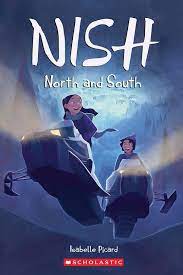Nish, North and South

Nish, North and South
Now the wolverine comes between me and my machine. I don’t dare move, breathe, or even look at it. The wolverine has let go of its first prey to set its sights on me, and I don’t know what to do. My father would know what to do. Maybe it’s thinking about my father that gives me some courage, but I find the strength to face the beast. At least with my eyes. I start to stare at him. He turns his head from left to right, then stares back at me for what seems like several long minutes, but which, in fact, must only last a few seconds. The wolverine, who had placed his front paws on the rock with the certain intention to climb up to me, puts them back on the ground, then turns his head away and slowly disappears into the woods.
I hear him walking away. I can finally breathe a little. Knowing that it’s possible he could come back, I wait a few minutes. No more sound comes from the trees. Nothing. I get up slowly without making any noise and I hurry back to my ATV. Wolverine has left me in peace. He knows me now. It’s as if I know him too.
In this novel translated from French, 13-year-old twins Leon and Eloise live in an Innu community in northern Quebec. Their community is shaken by the disappearance of family friend John Luther while hunting, with his body and snowmobile never found, in a suspected wolverine attack. The twins’ family is then shaken by the news that their father has cancer and has to go to far away to Quebec City for treatment. While he is away, Leon’s struggling local hockey team makes it to a tournament in the South for the first time. There Leon is able to visit with his father and with Eloise and her friends who discover a pile of scrap illegally dumped by the local iron mine, scrap that includes a piece of John Luther’s snowmobile. They produce a video on the dump which attracts media attention, but further investigation finds no link between the mine and John’s disappearance. The twins are then shocked by the news their parents have decided to move to the South for the kids’ education and their father’s follow-up treatment. They and their friends discover an injured wolverine in their hunting traps, and they set it free.
A timely addition to the growing body of Canadian children’s literature exploring modern Indigenous life, Nish, North and South presents a view of the Innu as a nation both thriving and haunted by economic and social injustice. The history of mining in northern Quebec, in particular the story of the abandoned mining town of Schefferville, is illustrated in some detail by conversations between the kids and their Kokum (grandmother), and the story is lightened by Leon’s hockey adventures and Eloise’s friendships and budding romance with Leon’s friend, Jocelyn. References to Innu folklore surrounding the Wolverine culminate in Leon’s seeming mastery of the dangerous animal. Overlaid on the story is their father’s fight for his health and to bring the family back together, illuminating the disparities between their Northern community and the South (Quebec City and their nearby Indigenous community of Wendake).
But the story is hampered by awkward structure, mediocre character development, and, in particular, what seems to be a poor translation. Teachers are variously referred to as Mr. and M. (Monsieur). The adults seem to speak in stilted, formal English, and the narration, alternating between Leon and Eloise, is often unnatural and unclear. Leon says of Eloise and Jocelyn: “What is this idea of my sister and my best friend?” Eloise says “my heart sinks” in reference to her mother’s calming and in-control tone. There are unexplained asides, as when Jocelyn suddenly says his shoulder is healed after a hockey injury, and when Leon refers conspiratorially to unspecified methods used to get him and Jocelyn on the same team. The overall arc of the story is fragmented and often loses its focus, in particular with the story surrounding the minor scandal at the mine, where Radio-Canada suddenly features it, but the reader is not told why it is so significant. Even the interweaving of the Wolverine myths with the rumors about John’s possible fate are so oblique that the reader is left baffled. The tone is almost too casual, paying too much attention to the kids’ pizza parties and typical pre-teen gossip, that the important content, including occasional references to alcoholism in their friends’ families, is obscured.
Nonetheless, a portrayal of Northern Indigenous youth as part of the Canadian mainstream, in particular one told from a unique Northern Quebec perspective, would be welcomed into any exhaustive collection on the theme, however imperfect the rendering.
Todd Kyle is the CEO of the Brampton Library in Ontario.
